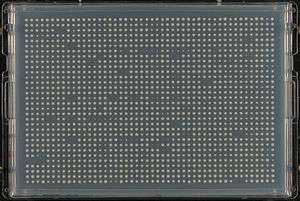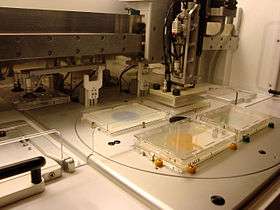Synthetic genetic array
Synthetic Genetic Array analysis (SGA) is a high-throughput technique for exploring synthetic lethal and synthetic sick genetic interactions (SSL).[1] SGA allows for the systematic construction of double mutants using a combination of recombinant genetic techniques, mating and selection steps. Using SGA methodology a query gene deletion mutant can be crossed to an entire genome deletion set to identify any SSL interactions, yielding functional information of the query gene and the genes it interacts with. A large-scale application of SGA in which ~130 query genes were crossed to the set of ~5000 viable deletion mutants in yeast revealed a genetic network containing ~1000 genes and ~4000 SSL interactions.[2] The results of this study showed that genes with similar function tend to interact with one another and genes with similar patterns of genetic interactions often encode products that tend to work in the same pathway or complex. Synthetic Genetic Array analysis was initially developed using the model organism S.cerevisiae. This method has since been extended to cover 30% of the S. cerevisiae genome.[3] Methodology has since been developed to allow SGA analysis in S.pombe[4][5] and E.coli.[6][7]

Background
Synthetic Genetic Array analysis was initially developed by Tong et al.[1] in 2001 and has since been used by many groups working in a wide range of biomedical fields. SGA utilizes the entire genome yeast knock-out set created by the yeast genome deletion project.[8]
Procedure
Synthetic Genetic Array analysis is generally conducted using colony arrays on petriplates at standard densities (96, 384, 768, 1536). To perform a SGA analysis in S.cerevisae, the query gene deletion is crossed systematically with a deletion mutant array (DMA) containing every viable knockout ORF of the yeast genome (currently 4786 strains).[9] The resulting diploids are then sporulated by transferring to a media containing reduced nitrogen. The haploid progeny are then put through a series of selection platings and incubations to select for double mutants. The double mutants are screened for SSL interactions visually or using imaging software by assessing the size of the resulting colonies.

Robotics
Due to the large number of precise replication steps in SGA analysis, robots are widely used to perform the colony manipulations. There are a few systems specifically designed for SGA analysis, which greatly decrease the time to analyse a query gene. Generally these have a series of pins which are used to transfer cells to and from plates, with one system utilizing disposable pads of pins to eliminate washing cycles. Computer programs can be used to analyze the colony sizes from images of the plates thus automating the SGA scoring and chemical-genetics profiling.
See also
References
- 1 2 Tong, A. H. Y.; Evangelista, M.; Parsons, A. B.; Xu, H.; Bader, G. D.; Pagé, N.; Robinson, M.; Raghibizadeh, S.; Hogue, C. W.; Bussey, H.; Andrews, B.; Tyers, M.; Boone, C. (2001). "Systematic Genetic Analysis with Ordered Arrays of Yeast Deletion Mutants". Science 294 (5550): 2364–2368. doi:10.1126/science.1065810. PMID 11743205.
- ↑ Tong, A. H. Y.; Lesage, G.; Bader, G. D.; Ding, H.; Xu, H.; Xin, X.; Young, J.; Berriz, G. F.; Brost, R. L.; Chang, M.; Chen, Y.; Cheng, X.; Chua, G.; Friesen, H.; Goldberg, D. S.; Haynes, J.; Humphries, C.; He, G.; Hussein, S.; Ke, L.; Krogan, N.; Li, Z.; Levinson, J. N.; Lu, H.; Ménard, P.; Munyana, C.; Parsons, A. B.; Ryan, O.; Tonikian, R.; Roberts, T. (2004). "Global Mapping of the Yeast Genetic Interaction Network". Science 303 (5659): 808–813. doi:10.1126/science.1091317. PMID 14764870.
- ↑ Costanzo, M.; Baryshnikova, A.; Bellay, J.; Kim, Y.; Spear, E. D.; Sevier, C. S.; Ding, H.; Koh, J. L. Y.; Toufighi, K.; Mostafavi, S.; Prinz, J.; St Onge, R. P.; Vandersluis, B.; Makhnevych, T.; Vizeacoumar, F. J.; Alizadeh, S.; Bahr, S.; Brost, R. L.; Chen, Y.; Cokol, M.; Deshpande, R.; Li, Z.; Lin, Z. -Y.; Liang, W.; Marback, M.; Paw, J.; San Luis, B. -J.; Shuteriqi, E.; Tong, A. H. Y.; Van Dyk, N. (2010). "The Genetic Landscape of a Cell". Science 327 (5964): 425–431. doi:10.1126/science.1180823. PMID 20093466.
- ↑ Roguev, A.; Wiren, M.; Weissman, J. S.; Krogan, N. J. (2007). "High-throughput genetic interaction mapping in the fission yeast Schizosaccharomyces pombe". Nature Methods 4 (10): 861–866. doi:10.1038/nmeth1098. PMID 17893680.
- ↑ Dixon, S. J.; Fedyshyn, Y.; Koh, J. L. Y.; Prasad, T. S. K.; Chahwan, C.; Chua, G.; Toufighi, K.; Baryshnikova, A.; Hayles, J.; Hoe, K. -L.; Kim, D. -U.; Park, H. -O.; Myers, C. L.; Pandey, A.; Durocher, D.; Andrews, B. J.; Boone, C. (2008). "Significant conservation of synthetic lethal genetic interaction networks between distantly related eukaryotes". Proceedings of the National Academy of Sciences 105 (43): 16653–16658. doi:10.1073/pnas.0806261105. PMC 2575475. PMID 18931302.
- ↑ Typas, A.; Nichols, R. J.; Siegele, D. A.; Shales, M.; Collins, S. R.; Lim, B.; Braberg, H.; Yamamoto, N.; Takeuchi, R.; Wanner, B. L.; Mori, H.; Weissman, J. S.; Krogan, N. J.; Gross, C. A. (2008). "High-throughput, quantitative analyses of genetic interactions in E. Coli". Nature Methods 5 (9): 781–787. doi:10.1038/nmeth.1240. PMC 2700713. PMID 19160513.
- ↑ Butland, G.; Babu, M.; Díaz-Mejía, J. J.; Bohdana, F.; Phanse, S.; Gold, B.; Yang, W.; Li, J.; Gagarinova, A. G.; Pogoutse, O.; Mori, H.; Wanner, B. L.; Lo, H.; Wasniewski, J.; Christopolous, C.; Ali, M.; Venn, P.; Safavi-Naini, A.; Sourour, N.; Caron, S.; Choi, J. Y.; Laigle, L.; Nazarians-Armavil, A.; Deshpande, A.; Joe, S.; Datsenko, K. A.; Yamamoto, N.; Andrews, B. J.; Boone, C.; Ding, H. (2008). "ESGA: E. Coli synthetic genetic array analysis". Nature Methods 5 (9): 789–795. doi:10.1038/nmeth.1239. PMID 18677321.
- ↑ http://sequence-www.stanford.edu/group yeast_deletion_project/deletions3.html
- ↑ http://www.openbiosystems.com/GeneExpression/Yeast/YKO/